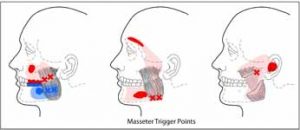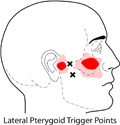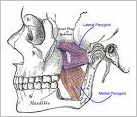This is a series on jaw pain and TMJ (temperomandibular joint) pain. If you missed the case study on Rodney D., go back to part 1.
Jaw pain is most commonly caused by tension in the muscles that close the jaw for chewing and clenching or grinding. There are three.
 The masseter lies on the outside of the lower angle of the jaw (mandible), attaching above to your cheekbone (zygomatic arch).
The masseter lies on the outside of the lower angle of the jaw (mandible), attaching above to your cheekbone (zygomatic arch).
On the inside of the mandible in the same place is the medial pterygoid, forming a sling for the jaw with the masseter.
 These partnered muscles work with the temporalis muscle that pulls from above. It does so from the side of the head above your ear with it’s tendon diving behind the cheekbone and attaching to the mandible under the zygomatic arch on the coronoid process.
These partnered muscles work with the temporalis muscle that pulls from above. It does so from the side of the head above your ear with it’s tendon diving behind the cheekbone and attaching to the mandible under the zygomatic arch on the coronoid process.

Most important next is the lateral pterygoid, the most significant cause of TMJ pain. Just in front of your ear, it attaches to the joint itself, to the knob of jaw bone (mandibular condyle) that inserts into the side of the skull (temporal bone), to the temporal bone itself and to the disc that separates the two.
 It is a team player, operating in concert with most of the jaw muscles and controlling movement at the temperomandibular joint. It’s three major actions are assisting in opening the jaw, protruding the lower jaw and side-to-side movements.
It is a team player, operating in concert with most of the jaw muscles and controlling movement at the temperomandibular joint. It’s three major actions are assisting in opening the jaw, protruding the lower jaw and side-to-side movements.
Other muscles that open the jaw are under the chin attaching to the horseshoe shaped hyoid bone above the “adam’s apple.” The most significant of these is the digastric, one of the three muscles that attach on the large rounded angle of bone right behind your earlobe (mastoid process). The two other muscles that attach to the mastoid are the SCM (sternocleidomastoid) of the neck and the top portion of one of the erector muscles of the spine called the longissimus capitis. These two are significant in their Trigger Point referral patterns to the ear, but don’t move the jaw.
Other muscles that are significant to jaw pain, although not necessarily to TMJ pain, are the trapezius, suboccipitals and platysma.
Now that you have a better idea of the actors in the play, let’s go back to Rodney D. and his treatment.